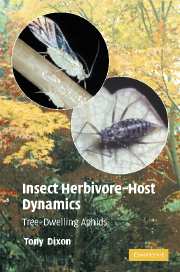Book contents
- Frontmatter
- Contents
- Preface
- 1 Introduction
- 2 Tree-dwelling aphids
- 3 Trees as a habitat: relations of aphids to trees
- 4 Trees as a habitat: relations of aphids to their natural enemies
- 5 Carrying capacity of trees
- 6 Aphid abundance
- 7 Population dynamics
- 8 Risky dispersal
- 9 Seasonal sex allocation
- 10 Aphids and tree fitness
- 11 Rarity, conservation and global warming
- Epilogue
- References
- Species index
- Subject index
3 - Trees as a habitat: relations of aphids to trees
Published online by Cambridge University Press: 08 August 2009
- Frontmatter
- Contents
- Preface
- 1 Introduction
- 2 Tree-dwelling aphids
- 3 Trees as a habitat: relations of aphids to trees
- 4 Trees as a habitat: relations of aphids to their natural enemies
- 5 Carrying capacity of trees
- 6 Aphid abundance
- 7 Population dynamics
- 8 Risky dispersal
- 9 Seasonal sex allocation
- 10 Aphids and tree fitness
- 11 Rarity, conservation and global warming
- Epilogue
- References
- Species index
- Subject index
Summary
In this and the following chapter the niche occupied by the sycamore aphid will be described. Elton (1927) was the first to adopt a dynamic approach to this concept. He argued that the external factors acting on an animal must be included when characterizing its niche, which he defined as: an animal's place in the biotic environment and its relations to food and enemies. This chapter gives an account of the relations of the sycamore aphid to sycamore, which serves as its home and source of food. In the next chapter the relations of the sycamore aphid to its natural enemies are presented.
DECIDUOUS TREES
Deciduous summer forests tend to dominate in those parts of Europe where summer temperatures are high and air is moist. Within this forest habitat there can be one or several dominant tree species, each of which is host to one or more species of aphid, most of which are highly host specific. That is, trees constitute the biotic environment of this group of aphids. Their niche is that of a relatively small herbivore feeding on the leaves of trees, which make up the forest canopy ‘one of the least explored zones on land’ (Elton, 1966).
The dominant species of tree in this habitat is often oak (Quercus spp.). Unlike oak, lime (Tilia spp.) and sycamore (Acer pseudoplatanus) trees rarely dominate over large areas.
- Type
- Chapter
- Information
- Insect Herbivore-Host DynamicsTree-Dwelling Aphids, pp. 18 - 42Publisher: Cambridge University PressPrint publication year: 2005



